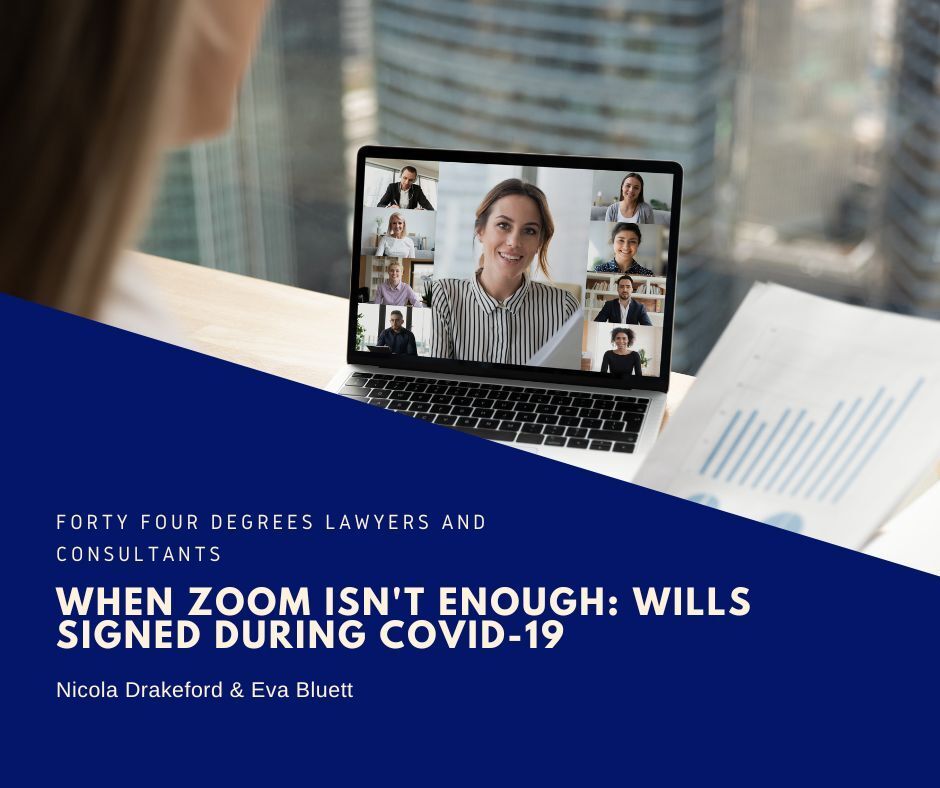When Zoom isn't enough: Wills signed during COVID-19
During COVID-19, a lot of law firms signed wills and power of attorneys electronically. Now, those documents may be invalid.

During the COVID-19 pandemic, many governments introduced new laws allowing wills and powers of attorney to be signed virtually. At the time, very little guidance was available on exactly what steps were required to make sure the signing was valid.
On 17 October 2022, the Supreme Court of Victoria handed down its first decision in Re Curtis [2022] VSC 621 concerning whether a will was validly executing in accordance with the remote execution procedure under section 8A of the Wills Act 1998 (Vic) (Wills Act).
In its judgment, the Supreme Court considered the minutiae of what exactly should be done to make a virtual will signing valid.
As the first decision of its kind, the Court granted leave to counsel as amici curiae to make submissions on the requirements of s8A.
Revisiting the remote execution requirements
Under s7 of the Wills Act, a will can be executed in accordance with the remote execution procedure. This procedure utilizes electronic signatures witnessing through audio-visual link, such as Zoom or Microsoft Teams.
To summarise, the testator first signs the document before any witnesses physically present sign. The document is then transmitted to any remote witnesses and/or the special witness. The remote witness must be satisfied that the document is the same document signed by the testator. Importantly, where audio-visual link is used, the parties must clearly see the signature being made by the singing party.
In Re Curtis, the Court provided vital clarification on what will amount to “clearly seeing” a signature being made.
The Execution of the Will in question
The testator used a computer to communicate via audio-visual link and a laptop to operate DocuSign for the purpose of executing the will. The testator held the laptop in front of the computer so that the witnesses could view the screen of the laptop and identify the document shown as the will. The laptop was then placed in front of the testator, out of the view of the camera. The special witness attested that she could clearly see the testator and plaintiff at the time of signing. The recording showed the testator sitting in front of the camera with the plaintiff present. However, the hands of the plaintiff and laptop could not be seen. The witness was then sent a link to the will, who was present with the testator. The witness shared her screen and confirmed that the witness, special witness and testator could see the will via the screen share. The special witness attested that she saw the witness via audio-visual link sitting in front of the computer and their signature being applied to the will. The same screen sharing processes was used for signing by the second witness and special witness.
The Court emphasized that while the ordinary execution procedure requires that the witness and testator sign “in the presence of” one another, remote execution carries the additional requirement that the signature must be clearly seen to be made. As such, it was held that this requirement was not satisfied, as the testators laptop remained out of view of the camera during signing. In respect to the witnesses’ signatures, the court was not satisfied that the testator saw the signatures being made. There was no verbal confirmation that the testator had witnessed the signature being made via the screen sharing, only that the will was visible. Additionally, the recording did not show either witness controlling the device.
What does this mean for practitioners?
It is now clear that s8A requires more than the parties being present by audio visual link. The decision suggests it is best practice to ensure the witnesses and testator can be seen via audio-visual link operating the device used to sign the document which can be identified as their will (such as sharing a screen). Where screen sharing is not used, the screen of the device must be in view as to allow the parties to see the signature appearing on the document. If screen sharing is used, it must be possible to identify the party controlling the device and causing the signature to appear. Special witnesses should seek verbal confirmation from the testator that they can see the signatures of the witnesses being applied to the will and that they are confident it is the witness applying that signature.
While the Wills Act does not require that the remote execution be recorded, the court confirmed that such recording can be of assistance in an application for probate. However, such recordings will not always be sufficient to prove the requirements of s8A.
Despite the decision in Re Curtis, practitioners can be assured that wills which do not comply with the remote execution procedure may still be admitted as informal wills. The Court has noted that for wills executed using the s8A procedure, an affidavit of due execution is likely to be requested. Additionally, special witnesses are advised to mark and sign a hard copy of the final will as to ensure the original will can be identified and provided upon making an application for probate.
I signed a will electronically during COVID-19 - what should I do?
You should speak with the lawyer who prepared and witnesses your will. If there is any question about the signing procedures, you should consider re-signing the will following the requirements in Re Curtis.
Forty Four Degrees can also assist in preparing new wills and/or arranging new wills signing, if needed. If you have concerns about the signing of your will or would like general advice in relation to your will, please feel free to contact our office.
Contact Us
We’re an Australian Law Firm promoting a nuanced, personal touch. We have the skills you need to resolve your case quickly and with a positive outcome. Our straight talking team stays close to simplify what is most often a complicated process. We help individuals and businesses with technology and startup law, property law including conveyancing and leasing, commercial law, civil litigation, wills, estates, bankruptcy, insolvency, criminal law, and professionals facing investigations and charges from their regulatory body.
We have a connected network of talented lawyers in Melbourne CBD, Dandenong, Ballarat, and Ivanhoe East.
Fill out the form or call us on 1300 892 237.
We will get back to you as soon as possible
Oops, there was an error sending your message.
Please try again later or call us on 1300 892 237.










